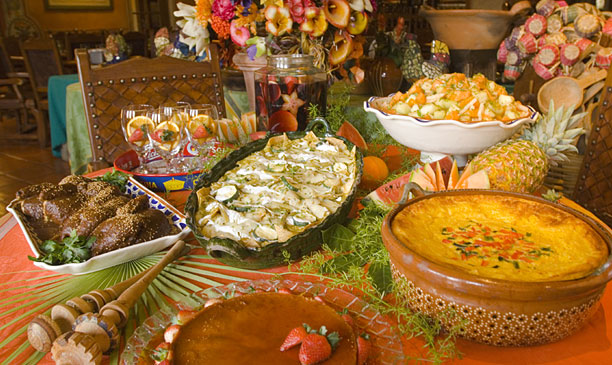Mexican Cuisine Can Be Heart-Healthy with a Few Modifications
TEXARKANA, Ark. –
The phrase, Cinco de Mayo, for many Americans means enjoying Mexican food, and many Mexican restaurants will tout specials for the day. But Cinco de Mayo, which means May 5 in Spanish, is actually about more than the Mexican food loved by so many, it commemorates the Mexican army's unlikely victory over the French forces of Napoleon III on May 5, 1862, at the Battle of Puebla.
Mexican food is a part of our culture and has been labeled in some instances as unhealthy, high in fat, and high in sodium. Those components that can increase your risk for cardiovascular disease.
Although cardiovascular disease is often thought to primarily affect men and the elderly, it is also a major killer of women and people in the prime of their life. More than half of all cardiovascular disease deaths each year occur among women. This should be a wakeup call for females everywhere.
What can we do to enjoy our favorite food south of the border and still be healthy? Make our Mexican dishes healthier or make healthier choices when eating out.
Regardless of whether it is prepared at home or eating out, Mexican food has become a staple of many Americans diets. You may order sizzling fajitas, enchiladas, chimichangas, nachos, or even sopapillas and fried ice cream.
You can still enjoy your favorite Mexican foods by making a few modifications to reduce the fat and make it heart healthy when you prepare it at home. Start with the oils called for in the recipe.
If a traditional Mexican recipes call for shortening, use polyunsaturated vegetable oils, such as safflower, corn or canola. Polyunsaturated fats are those that are usually liquid at room temperature, and are found in plant foods such as vegetables and corn. Monounsaturated fats are those found in canola oil and olive oil, and may actually lower the risk of heart disease. Saturated fats are those fats that are solid at room temperature and include lard, shortening, butter and cheese and milk fat. These should be eaten in small amounts.
When a recipe calls for sour cream as a condiment or in the recipe, a healthier, low-fat substitution is plain Greek yogurt. Not only will you be reducing the fat content, you will increase protein.
If chimichangas are your favorite, reduce the fat by skipping the deep frying stage, and bake them instead. Brush lightly with oil and bake at 350 degrees until crisp and browned. Corn tortilla chips can benefit from this too. Just cut a dozen corn tortillas into wedges, brush lightly with oil and brown in hot oven until crisp. Corn tortillas for tostados can be prepared the same way.
Select leaner cuts of meats to reduce fat content. Look for cuts of meat without a lot of fat in the meat. Skirt steak is great for fajitas and is a lean cut of meat. If purchased untrimmed, remove extra fat and the silver grey lining with a sharp knife, then grill.
Of course meatless meals are always an option and will be good for your diet and pocketbook. Dried beans are a good source of protein like meats, but are much lower in fat, and less expensive.
Always try to incorporate fresh vegetables into your Mexican dish. They will add flavor and texture without adding fat or sodium.
For more information, or a free chart on what fresh vegetables should be arriving at your farmers market, contact the Miller County Extension Office, 870-779-3609 or visit us in room 215 at the Miller County Courthouse. We're online at chadley@uada.edu, on Facebook at UAEXMillerCountyFCS/CarlaHaleyHadley, on Twitter @MillerCountyFCS or on the web at uaex.uada.edu/Miller.
These are just a few changes you can make in your cooking style to make Mexican foods taste great, yet be good for your heart. Pico De Gallo is easily made, can be stored in the refrigerator and all ingredients can be purchased fresh.
Pico De Gallo
4 sprigs fresh cilantro (or one fourth tsp. coriander powder)
4 large fresh tomatoes, chopped
1 small onion, chopped
1 finely minced garlic clove
2-3 fresh jalapeno peppers (if you like it hot, leave the seeds)
Combine all ingredients in food processor or chop coarsely with a knife. Refrigerate until ready to use. Serve with fajitas, or over eggs, on tostadas, tortillas or with baked corn chips. Makes about 3 cups.
By Carla Haley-Hadley
County Extension Agent - FCS
The Cooperative Extension Service
U of A System Division of Agriculture
Media Contact: Carla Haley-Hadley
County Extension Agent - FCS
U of A Division of Agriculture
Cooperative Extension Service
400 Laurel Street, Suite 215 Texarkana AR 71854
(870) 779-3609
chaley@uada.edu
The Arkansas Cooperative Extension Service is an equal opportunity institution. If
you require a reasonable accommodation to participate or need materials in another
format, please contact your County Extension office (or other appropriate office)
as soon as possible. Dial 711 for Arkansas Relay.
Pursuant to 7 CFR § 15.3, the University of Arkansas System Division of Agriculture
offers all its Extension and Research programs and services (including employment)
without regard to race, color, sex, national origin, religion, age, disability, marital
or veteran status, genetic information, sexual preference, pregnancy or any other
legally protected status, and is an equal opportunity institution.
